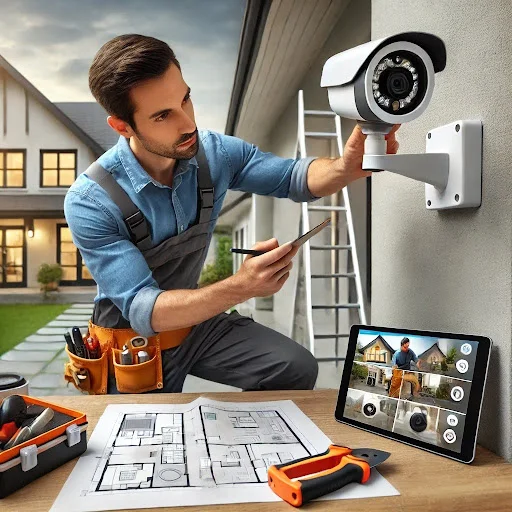In the modern day and age, it is more crucial than ever to ensure your home or business is safe. Installing a CCTV camera system is one of the best methods to improve security. Placing security cameras at optimal locations helps both to deter crime from happening and to collect critical information after problems arise.
What are the necessary steps to install CCTV cameras effectively? Many people in Kent who require CCTV installation often choose to do it themselves rather than hire professionals. If you’re looking for a proper CCTV installation in Kent, we’ll guide you through the correct way to set up your cameras by sharing important installation information and useful tips.
Step:1 Designing Your CCTV System Layout
Prepare a clear plan before you start with CCTV installation. The system depends fully on correct positioning and camera coverage.
Consider the following:
- Decide which main locations you want your cameras to monitor, such as front and back entrances and areas without visibility.
- Choose the correct CCTV camera model for installation, including wired or wireless systems and indoor or outdoor environments.
- Verify the viewing space has enough lighting to avoid bright spots and dark recording areas.
- Base your CCTV system on available wireless internet if using wireless cameras.
A poorly thought-out security setup will leave your safety system ineffective.
Step 2: Choose the Right Camera Type
Available CCTV camera types exist to fulfil targeted security needs.
- A bullet camera detects what lies far away from the property, such as at driveway entrances or fence lines.
- Dome Cameras: Best for indoor monitoring with a 360° view.
- Wireless Cameras: Simpler to install but rely on a good internet connection.
- PTZ Cameras: Enable remote panning, tilting, and zooming for enhanced surveillance.
Buying the correct model provides enhanced security and productivity.
Step 3: Install CCTV Cameras in the Proper Places
Now that you have your cameras, it’s time to install them. This is what you should do:
- Position the camera high – Preferably 8-10 feet off the ground to avoid any tampering.
- Pivot it correctly – Place the camera to capture the area you need without anything in the way.
- Steer clear of backlight problems – Avoid placing cameras directly in the line of bright light sources.
- Seal outdoor cameras against the weather – If installing outdoors, make them waterproof and properly mounted.
Placement is essential to achieve a clear and useful video.
Step 4: Install CCTV Camera System Wiring
The wiring process will differ based on the type of camera you have.
- For wired cameras
- Install the cables from the camera to the DVR/NVR.
- Utilise hidden wiring to avoid tampering.
- Securely connect the power supply.
- For wireless cameras:
- Maintain a strong Wi-Fi signal.
- Sync the cameras using the mobile app or monitoring system.
Pro tip: Utilise cable clips to organise wiring tidily!
Step 5: Connect the Cameras to the Recorder and Monitor
Once the cameras are installed, you must connect them to a Digital Video Recorder (DVR) or Network Video Recorder (NVR) so that you can store and view the footage.
Connection Process:
- For DVR systems: The cameras are connected via coaxial cables.
- For NVR systems: Cameras are connected via a network switch or Wi-Fi.
- For individual wireless cameras: Set up using an app.
After connecting, switch on the system and verify whether the cameras are working properly.
Step 6: Set up the CCTV System Settings
For having proper CCTV installation, you’ll now need to adjust the settings for maximum performance.
- Tweak motion detection settings to minimise false alarms.
- Create remote access so you can view footage from your phone or laptop.
- Turn night vision on if your camera is capable of this.
- Schedule recordings to conserve storage space.
Having a properly configured system means that you receive maximum security coverage with minimal alerts.
Step 7: Test and Maintain Your CCTV System
After everything is installed, do a test run to identify any blind spots or connectivity problems.
Maintenance Tips:
- Clean camera lenses regularly to maintain clear video.
- Inspect cables and connections for signs of wear and tear.
- Update firmware to enhance security and performance.
- Backup critical footage to avoid data loss.
Regular maintenance will keep your CCTV system running for years to come.
Conclusion
CCTV installation can appear to be complicated, but with careful planning and execution, it is possible. Whether you install CCTV cameras yourself or hire professional for CCTV installation, proper placement and configuration are the most important factors in effective security.
If expert support is your priority, Patron Security Ltd provides quality CCTV solutions for domestic and commercial premises. Having a top-grade system installed reassures you that your property is in safe hands. Have trouble with CCTV installation in Kent? Contact the experts now!







